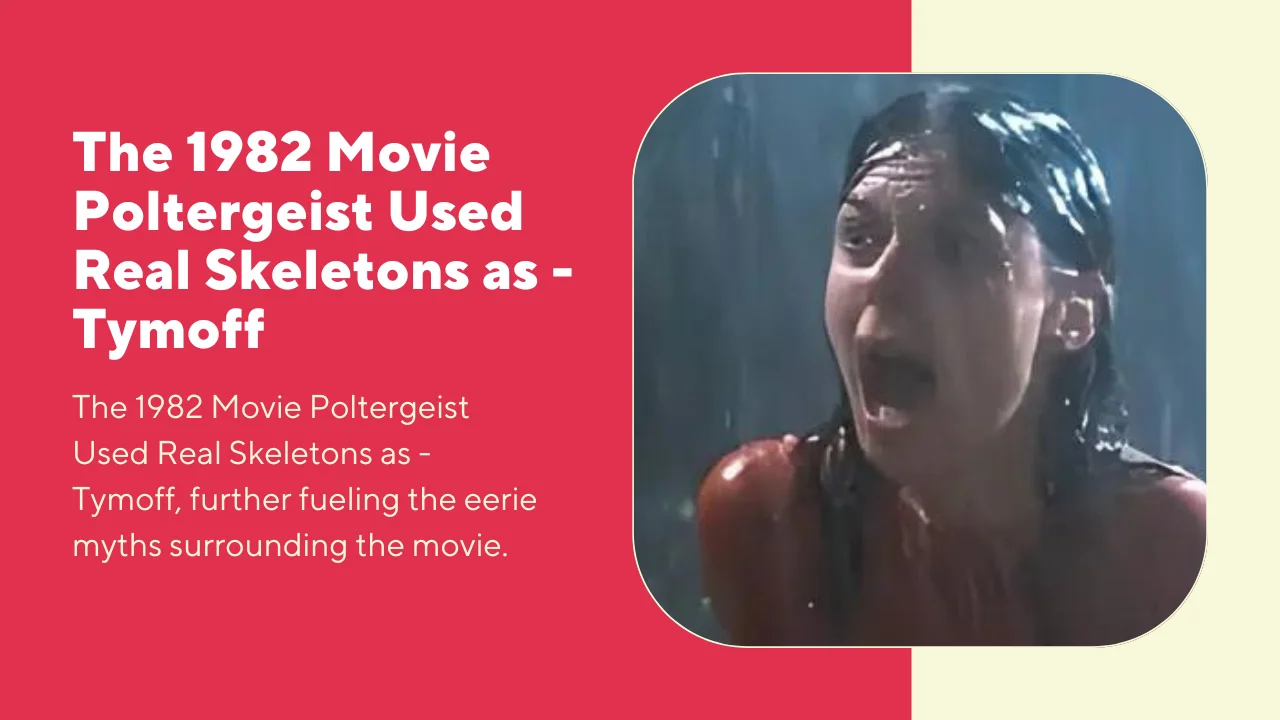A classic of the horror genre, Poltergeist (1982) captivates viewers with its spine-tingling plot and unsettling atmosphere. Beyond the film’s fictitious horrors, though, the film’s alleged use of real human skeletons in its production has been a real-life controversy for decades. This disturbing rumor has stirred discussions about ethics, superstitions, and the fuzziness of the boundary between Hollywood illusion and reality, in addition to adding to the film’s legacy. In fact, The 1982 Movie Poltergeist Used Real Skeletons as – Tymoff, further fueling the eerie myths surrounding the movie.
The Background of the 1982 Movie Poltergeist
The Making of Poltergeist
The groundbreaking special effects and riveting plot of 1982’s Poltergeist helped propel the film into the canon of horror classics. The film follows a suburban family who, after building their home on top of a former cemetery, become the targets of evil spirits in this Steven Spielberg and Tobe Hooper production. The film became a cultural phenomenon thanks to its effective blend of supernatural horror with the relatable anxieties of an upper-class family.
The Infamous Pool Scene
The pool scene, in which JoBeth Williams’s character, Diane Freeling, a mother, is stranded in a muddy pool with skeletons floating around her, is both a memorable and terrifying part of Poltergeist. Many people think that real human remains were utilised in the filming of this scene, which has become the centre of the real skeletons controversy.
The Decision to Use Real Skeletons
Why Were Real Skeletons Used by Poltergeist?
The use of actual bones in Poltergeist was actually more common than it appears now. It was an expensive ordeal to make skeletons that looked realistic in the 1980s. Compared to using synthetic materials, using actual human remains was less expensive and more authentic. The decision was motivated by a desire for realism in a horror film that heavily relied on practical effects and budget constraints.
Verification from the Executives and Performers
It has been verified by multiple crew and cast members that actual skeletons were utilised in the making of Poltergeist. The actress who recorded the iconic pool scene, JoBeth Williams, has spoken frankly about how uneasy she felt when she realised the skeletons she was filming were real. She brought an extra layer of real, unstaged terror to her performance with this revelation that came after the scene was shot.
The Ethical Implications
Using Human Remains: A Moral Conundrum
There are serious moral questions that arise when films use actual skeletons, especially in a horror setting. Taking into account cultural and legal factors, human remains are typically handled with the utmost respect and dignity. Many are questioning the ethics of the decision to utilise them as props in the film Poltergeist. Were medical or scientific reasons behind the donation of these remains? If that is the case, wouldn’t their use in a horror movie be a betrayal of their generosity?
Audience and Industry Reactions
Reactions from both audiences and industry insiders were mixed when word got out that Poltergeist used actual skeletons. Others were horrified by what they saw as a callous disregard for the dead, while others thought it was a shocking but effective choice to up the film’s horror factor. Because of this controversy, the film became even more famous, serving as both a real-life horror story and a topic of heated debate.
How It Will Affect Poltergeist’s Afterlife
The Curse of Poltergeist
Many have speculated that the “Poltergeist curse,” a string of unfortunate events that befell the film’s cast and crew after its release, was connected to the use of actual skeletons in Poltergeist. Heather O’Rourke, who played Carol Anne, was one of several actors whose deaths were shrouded in mystery. The film’s association with actual skeletons has contributed to superstitions and a sense of dread, even though the concept of a curse lacks any scientific foundation.
Influence on Future Horror Films
The controversy surrounding Poltergeist’s use of real skeletons has had a variety of impacts on the horror genre. With a heightened focus on ethical considerations, filmmakers have grown more careful with the tools and techniques they employ. Particularly in horror films, where the boundary between fact and fiction is more likely to become blurry, the incident established a precedent for the significance of honesty in the industry.
Did the 1982 Movie Poltergeist Really Use Real Skeletons?
Indeed, this is a very popular question regarding Poltergeist, and the response is affirmative. Members of the cast and crew, among others, have verified that actual skeletons were used in the film. Though horrifying now, this was actually rather normal back then, and that is something you must keep in mind. When realism was paramount, it was common practice to use real skeletons in film.
What Scenes in Poltergeist Used Real Skeletons?
Although real skeletons are most famously seen in the pool scene, they may have appeared elsewhere in the film as well. Real skeletons might have been utilised in multiple scenes depicting human remains, considering the film’s heavy use of practical effects and the intention to generate truly horrifying imagery. Still, few examples can compare to the pool scene.
Real Skeletons’ Influence on Film
A Macabre Tradition in Cinema
Real skeletons have been used in film before Poltergeist, in early horror films and even in certain mainstream features. The pursuit of realism, especially in a genre that enjoys playing with the boundaries between reality and the fantastic, was the inspiration for this technique. This spooky practice, however, has fallen out of favour as special effects technology has made life with actual human remains unnecessary.
The Shift to Ethical Practices
Filmmakers have become much more conscientious of their ethical responsibilities since the Poltergeist controversy. Rather than using actual human remains, modern horror films use state-of-the-art special effects and digital technology to create terrifying scenes. The industry’s attitude towards ethics and respect for the dead has changed, and this shift is a reflection of that.
Emotional Reactions from Viewers and Their Long-Term Effect on the Audience
For many viewers, the knowledge that real skeletons were used in Poltergeist adds an extra layer of fear and discomfort when watching the film. Not only do the scenes themselves elicit this reaction, but so do the ethical considerations and the hazy lines between fact and fiction. Audiences are still reeling from the disturbing notion that a seemingly harmless film could incorporate actual human remains.
Poltergeist’s Role in Pop Culture
Poltergeist has become an enduring part of popular culture, whether or not the controversy was a contributing factor. The film’s real-life myths and legends, along with its story and effects, have led many to call it one of the best horror films of all time. The film’s incorporation of actual skeletons has become an integral aspect of its character and has helped establish it as a cultural landmark.
FAQS
1. Did the 1982 movie Poltergeist really use real skeletons?
Yes, real skeletons were used in certain scenes of the 1982 movie Poltergeist, most notably in the infamous pool scene.
2. Why did the filmmakers use real skeletons in Poltergeist?
Real skeletons were used because they were more cost-effective and realistic compared to artificial skeletons available at the time.
3. Which scenes in Poltergeist featured real skeletons?
The most famous scene featuring real skeletons is the pool scene where JoBeth Williams’ character encounters skeletons emerging from the water.
4. How did the cast react to the use of real skeletons in Poltergeist?
Several cast members, including JoBeth Williams, expressed discomfort and shock upon learning that real skeletons were used during filming.
5. What impact did the use of real skeletons have on the film’s legacy?
The use of real skeletons contributed to the film’s eerie reputation and is often cited as part of the so-called “Poltergeist curse,” adding to the movie’s lasting legacy in horror cinema.
Also Read: Showbizztoday.com Celebrity Gossip Music
Conclusion
An intriguing example of how real-life choices can impact a film’s legacy is the story of Poltergeist and its use of real skeletons. Using human remains was a pragmatic decision back then, but now it’s a hotly debated topic that has only served to heighten the film’s already unsettling reputation and give rise to the urban legend of the “Poltergeist curse.” The mystery surrounding this timeless horror film will always revolve around the tale of the actual skeletons. The 1982 Movie Poltergeist Used Real Skeletons as – Tymoff, further fueling the eerie aura and the fascination with the film’s dark production choices.
Investigating Poltergeist in this way serves to draw attention to the tangled web of morality in the entertainment industry and the enduring influence that decisions made in the shadows can have on a picture’s reputation. The usage of actual skeletons in Poltergeist, whether seen as a warning story or an interesting anecdote in the annals of horror filmmaking, captivates and horrifies viewers even now.

